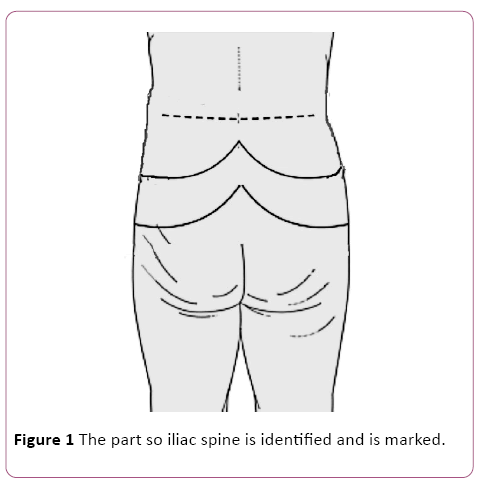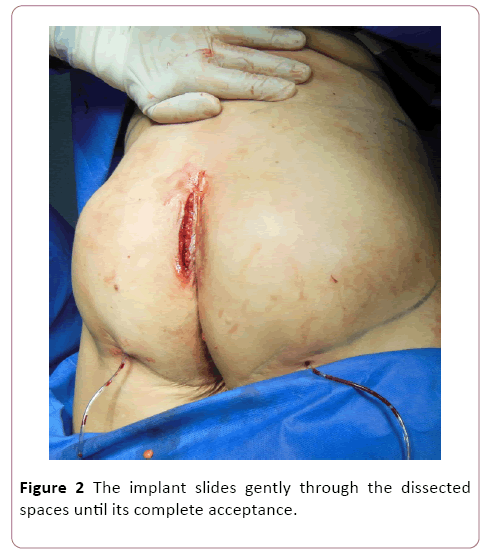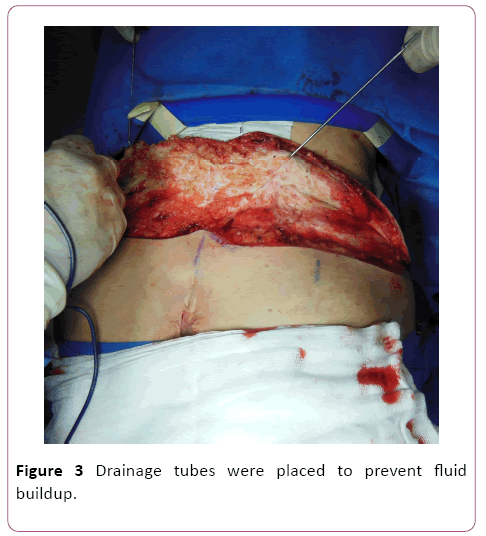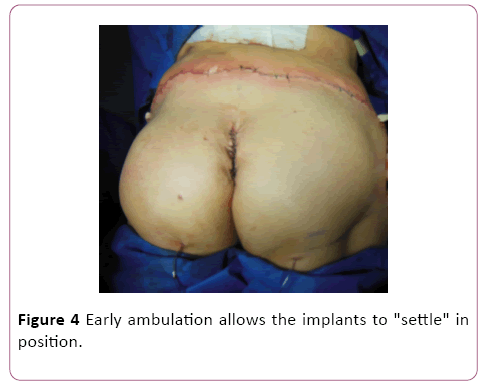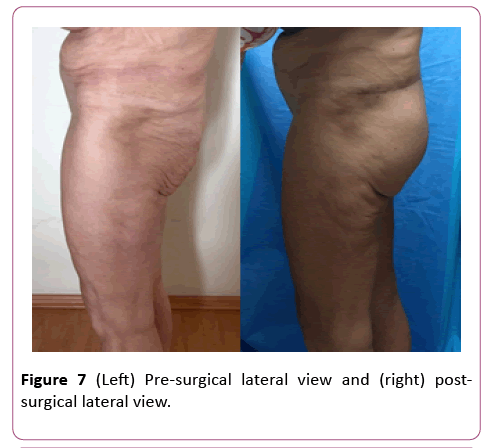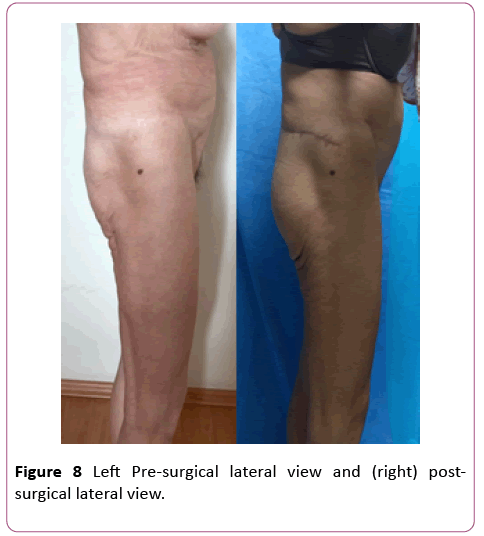Senile Buttock Lifting (One Case)
Guzmán YA, Olivares J and Torres E
DOI10.4172/2472-1905.100036
Guzmán YA1*, Olivares J2 and Torres E3
1Centro de Cirugía Ambulatoria 1 de Octubre ISSSTE, Mexico City, Mexico
2Department of Aesthetic Surgery, Instituto de Estudios Superiores en Medicina, Mexico City, Mexico
- *Corresponding Author:
- Guzman YA
Plastic, Reconstructive and Aesthetic Surgeon
Centro de Cirugía Ambulatoria 1 de Octubre ISSSTE
Mexico City, Mexico
Tel: (462) 6233300
E-mail: yader74@hotmail.com
Received Date: February 15, 2018; Accepted Date: February 26, 2018; Published Date: March 05, 2018
Citation: Guzman YA, Olivares J, Torres E (2018) Senile Buttock Lifting (One Case). J Aesthet Reconstr Surg 4:2. doi: 10.4172/2472-1905.100036
Abstract
After the massive weight loss, in the gluteal region, there is disagreement with the appearance of the form and has the desire to improve its appearance. This paper describes the combination in a senile patient, the application of buttocks implants and the technique of lifting the buttocks.
https://marmaris.tours
https://getmarmaristour.com
https://dailytourmarmaris.com
https://marmaristourguide.com
https://marmaris.live
https://marmaris.world
https://marmaris.yachts
Keywords
Buttock; Implant; Torsoplasty; Senile
Introduction
The senile buttock lifting is usually done in patients who have lost a lot of weight (usually after a gastric bypass surgery or another type of Bariatric surgery) and associated with aging, so have loose skin hanging them around the entire body.
They are candidates for buttock augmentation that lack of projection in the gluteal region and have the desire to improve their form [1-3].
History of the procedure
Gonzalez Ulloa in 1977 was the first surgeon in proposing to rebuild the gluteal region, either by lifting buttocks or placement by the infragluteal fold of a subcutaneous implant. With this technique, aponeurotic expansion going from the dermis to the aponeurotic of the gluteal muscle should divide and left loose skin with own displacement of the implant, the results were poor aesthetic results [4,5].
It is of vital importance to mark when the patient standing, sitting and lying (Figure 1).
When the patient is lying down, depression becomes a little more cephalic and the iliac spine is located in a most flow position. The iliac crest is palpable and is marked. As it feels, we find the trochanter its projection is marked.
Starting thorn iliac supero posterior measured 5 cm laterally by drawing a line straight into the iliac crest indicates the lateral boundary of the gluteus originally on the iliac crest. Draw a line from the side limit of the muscle of iliac crest brand to the postero-lateral trochanter appearance. In fact, this line is a projection of the imaginary line in the skin.
Prone, prior soapy water sterile asepsis and antisepsis with antiseptic sterilizing solution of over-oxidation, after isolating the anal orifice with antiseptic-impregnated gauze.
It is recommended to perform two parallel incisions, to prevent the tissue suffering of supra groove. The incisions are marked at 7 centimeters in parallel in the upper lateral part of the intergluteal sulcus to preserve the cutaneous sacral ligament. When influencing; the fascia is located 3 cm. from the infragluteal fold. After affecting the skin, it is accessed obliquely, leaving a prominence in the subcutaneous tissue. This serves as a barrier of separation and protection of the spaces between the buttocks.
The subcutaneous cellular tissue was dissected with the fibres of the majeure gluteus muscle.
At this level, an opening is made between the medial gluteus muscle and the gluteus mayor, the inferior pyramidal muscle (sub-gluteal cell space described by Robles) [6]. The peeling should divide the muscle in half and the same amount of muscle is left front and behind the implant. If these principles are not fulfilled, we can end up dissecting deep or superficially or even leaving the muscles, either anteriorly or later. For the introduction of the prosthesis, the implant slides gently through the dissected spaces until its complete acceptance (Figure 2).
The contralateral implant is introduced, the reference position of the implants is revised, its placement and symmetry is assessed, and the suture is performed on three levels: muscle fibers and subcutaneous tissue with Vicryl 3-0 and skin with Nylon 3-0 [7,8].
It was combined with the lifting of the buttocks, and the scars are located, in the posterior side, at the level of the iliac spine Antero Superior, approximately three fingers below the iliac crest.
In an approach in the lower back region, the incision extended posteriorly along the entire circumference of the patient's torso, through which excess skin and fat were eliminated (Figure 3).
Once the excesses of skin and fat are removed, it is closed in 3 planes. Drainage tubes were placed to prevent fluid buildup (Figure 4).
In the course of evolution, there are complications resulting from the trans operative management: Large undermining, which cause displacement and/or rotation of the implant, retraction of the skin, by accumulation of fluid in dead space, and asymmetry between other (Figure 5) [9-11].
Case Presentation
It's a 73-year-old female patient, which concerned inconformity with the appearance of the shape of the buttocks. With this combination of techniques the folds of the back were smoothed and the buttocks were raised and with better shape. There is a lot of satisfaction in the patient for the considerable improvement in the appearance. Results of this procedure are shown in (Figures 5-8).
Discussion
The surgical techniques described have been extended to treat this population of patients. Sometimes there are complications resulting from the trans operative management: Large undermining, which cause displacement and/or rotation of the implant, retraction of the skin, by accumulation of fluid in dead space and asymmetry between other.
Conclusion
After the massive weight loss associated with bariatric treatments for obesity creating severe deformities, it has accelerated the development of various medical and surgical procedures for body shaping and to give better shape to the gluteal region.
References
- Mendieta CG(2003) Gluteoplasty. Aesthet Surg J 23:441-455.
- Cuenca-Guerra R, Quezada J (2006) What makes buttocks beautiful? A review and classifications of the determinants of gluteal beauty and the surgical techniques to achieve them. Aesth Plast Surg 28: 340-347.
- Babuccu O, Gozil R, Ozmen S (2002) Gluteal region morphology: The effect of the weight gain and aging. Aesthet Plast Surg 26(2): 130-133.
- González-Ulloa M (1977) A review of the present status of the correction for sad buttocks. 4th Congress International Society of Aesthet Plastic Surgery, Mexico City.
- González-Ulloa M (1960) Belt lipectomy. Br J Olast Surg 13: 179-186.
- Robles JM, Tagliapietra JC, Grandi MA (1984) Gluteoplastia de augmento: Implantes submuscular. Cirplast Ibero Latinoam 10: 365-369.
- Cárdenas-Camarena L, Paillet JC (2007) Combined gluteoplasty: Liposuction and gluteal implants. Plast and Reconstr Surg 1067-1074.
- Buchuk L (1986) Complications with gluteal prosthesis. Plast Reconstr Surg 77(6): 1012.
- Carwell Gr, Horton CE Sr (1997) Circumferential torsoplasty. Ann Plast Surg 38: 213-216.
- Strauch B, Rohde C, Patel MK, Patel S (2007) Back contours in weight loss patients. Plast Reconstr Surg 120: 1692-1696.
- Regnault P, Daniel R (1984) Secondary thigh-buttock deformities after classical techniques: Prevention and treatment. Clin Plast Surg 11: 505-516.
Open Access Journals
- Aquaculture & Veterinary Science
- Chemistry & Chemical Sciences
- Clinical Sciences
- Engineering
- General Science
- Genetics & Molecular Biology
- Health Care & Nursing
- Immunology & Microbiology
- Materials Science
- Mathematics & Physics
- Medical Sciences
- Neurology & Psychiatry
- Oncology & Cancer Science
- Pharmaceutical Sciences
